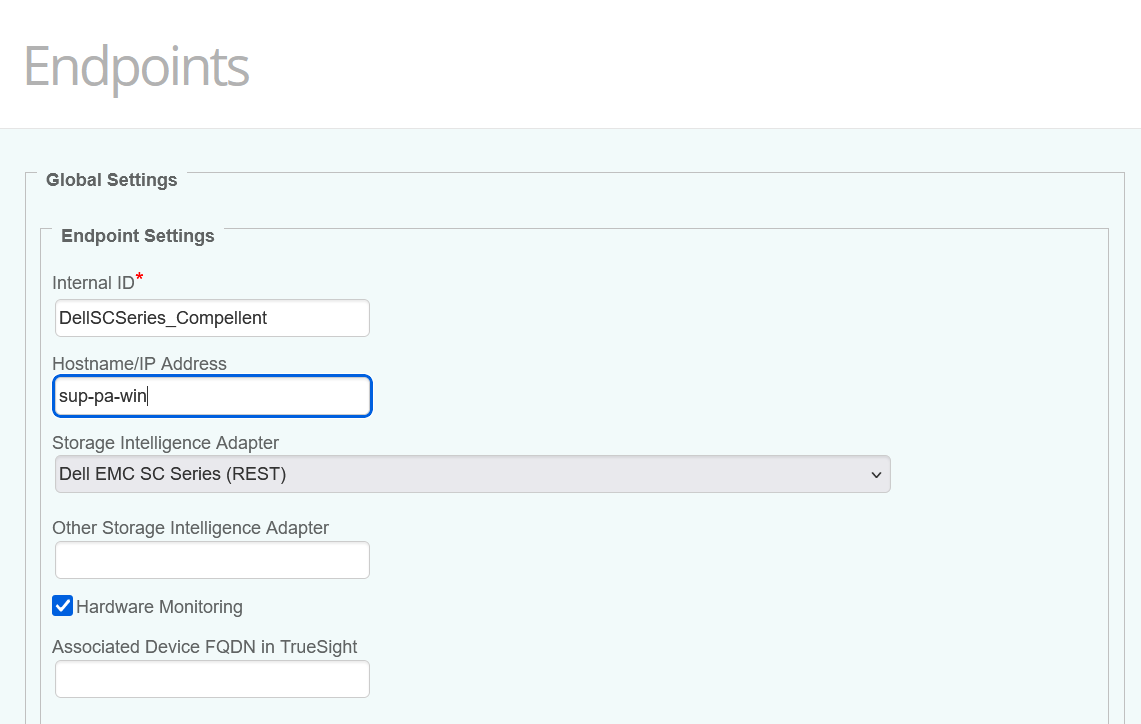Introduction
This article explains how to configure the Dell EMC SC Series (REST) adapter to monitor Dell EMC SC Series devices, also known as Compellent, via Unisphere Central for SC Series/Dell EMC Storage Manager using the REST API protocol. More specifically, the KM communicates with the Data Collector service, which listens on port 3033 by default and is accessible via https://<Unisphere_hostname>:3033
Prerequisites
Before configuring the policy:
-
Read these articles to make sure the prerequisites are met:
-
Download and run the Dell Compellent Troubleshooting Tool from the same PATROL Agent, and verify you can collect data against the same endpoint:

For optimal performance, we recommend reserving 2 CPU cores and at least 4 GB of RAM for operating the Storage Analyzer KM. The amount of memory allocated to the Java engine of the KM may be adjusted via the /SENTRY/STORAGE/collectionHubHeapSizeMax configuration variable. For more details, refer to:
Procedure
-
Log in to TrueSight/Helix Operations Management
-
Create a new monitoring policy:
- Specify the general properties and agent selection criteria
- Add a monitoring configuration
- Select the Storage Analyzer solution
- In the Storage Configuration section, click Add to create a new Endpoint

-
Configure the Endpoint Settings:
- Enter an Internal ID
- Specify the Hostname/IP address of Unisphere Central for SC Series/Storage Manager/Data Collector
- Select Dell EMC SC Series (REST) from the Storage Intelligence Adapter dropdown list
- (Optional) Specify a custom device name in the Associate Device FQDN in TrueSight field. For more details, refer to More Easily Identify Your Devices Monitored Through a Proxy in TrueSight / Helix Operations Management.

-
Configure the Endpoint Connection Settings:
- Provide the Username and Password
- Specify the port (3033 by default)
- Check Encryption if using the HTTPS protocol.

-
Configure the Advanced Settings:
- In large environments, we recommend increasing the values of the Discovery and Polling Intervals to maintain the workload of the PATROL Agent and monitored systems at a reasonable level.
- Since volume monitoring is highly resource-intensive, we recommend disabling it if not needed to reduce the workload on the KM and PATROL Agent.
- Because displaying thousands of volumes will have a huge impact on the PATROL Agent and on BMC TrueSight/Helix, volumes are discovered but NOT displayed. Uncheck the Hide Volume Instances box if required.

-
Save the policy and verify that it applies to the right PATROL Agent.
-
Allow the KM some time to discover your storage system(s). Access the Devices page and search for their hostname, IP address, FQDN, or custom MetaFQDN/Device Name. You can also refer to the article Identifying and Locating Devices in TrueSight to learn how to run the below PSL script in the Query PATROL Agent window:
CLASS_NAME = "SKM_SYSTEM"; nodes = get_vars("/".CLASS_NAME, "subnodes"); foreach node (nodes) { objectPath = "/".CLASS_NAME."/".node; instanceName = get(objectPath."/MetaFQDN"); output = [output, "Device Name: ".instanceName ]; } print(output);
Related Topics
- How to Monitor Dell EMC Unity Storage Systems with Storage Analyzer KM
- How to Monitor Dell EMC ScaleIO/PowerFlex Storage Systems with Storage Analyzer KM
- How to Monitor Dell EMC Isilon/PowerScale Storage Systems with Storage Analyzer KM
- How to Monitor Dell EMC VMAX/PowerMax Storage Systems with Storage Analyzer KM
- How to Monitor Dell EMC PowerProtect DD Storage Systems with Storage Analyzer KM
